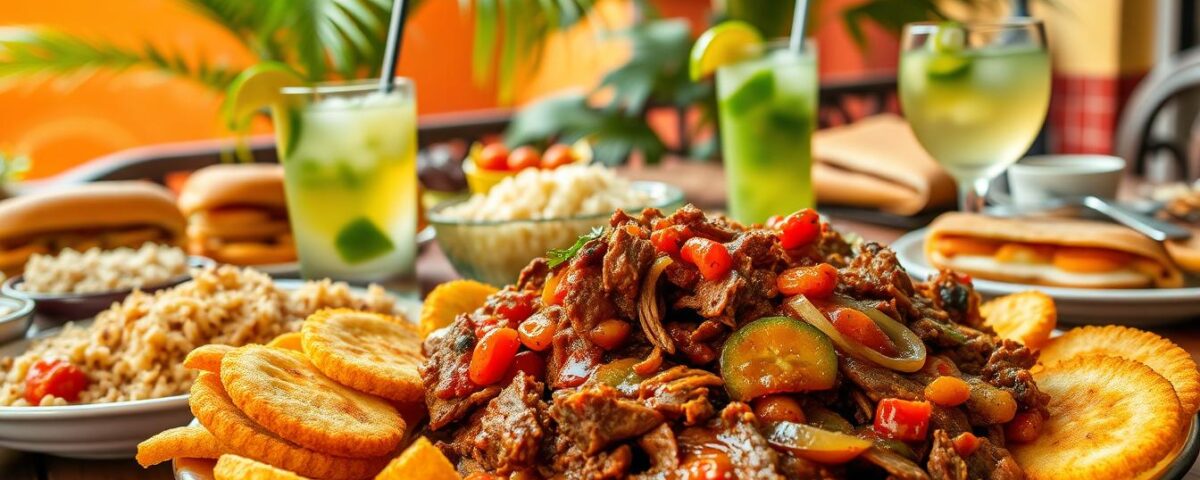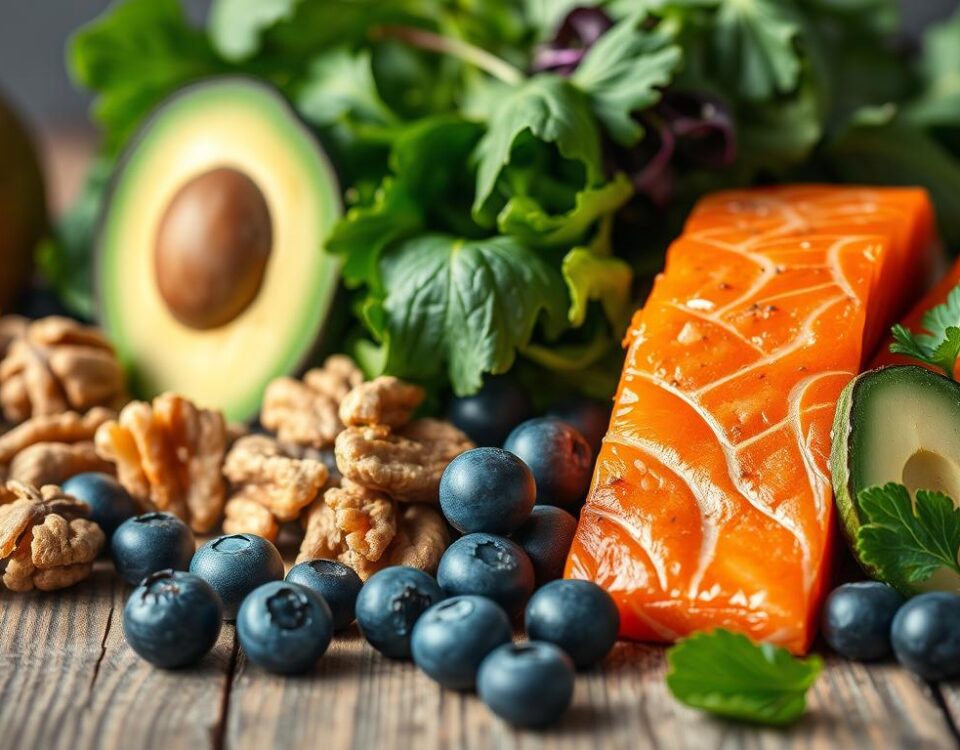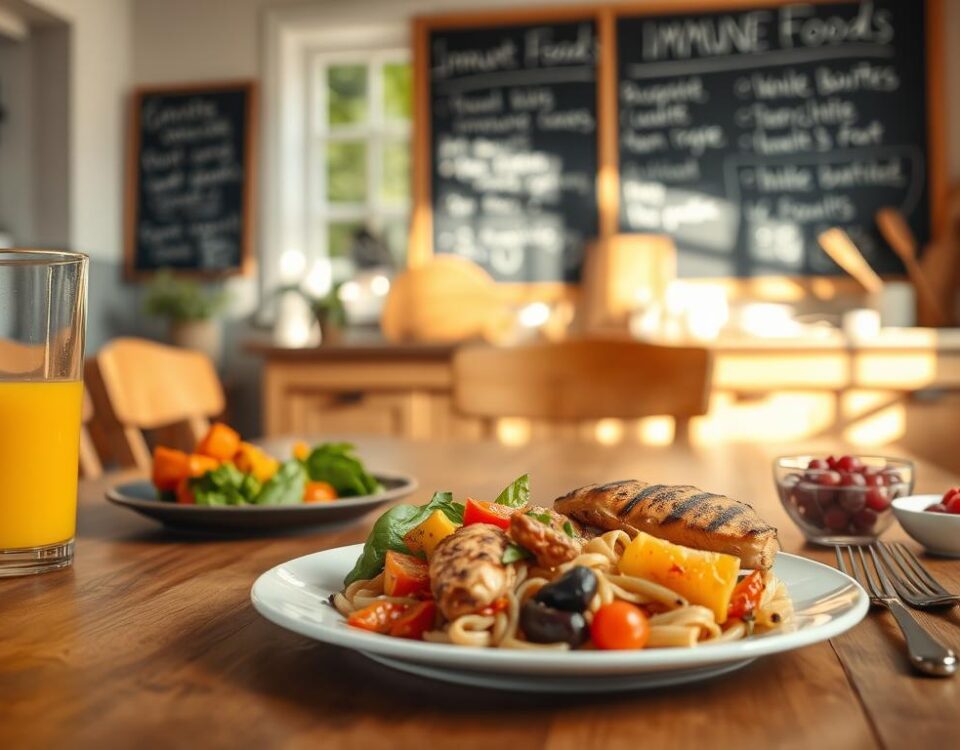
Why Everyone Is Talking About Filipino Food (Try These 3 Recipes!)
April 30, 2025
Hungarian Classics: How to Make the Perfect Goulash
May 1, 2025I’ll never forget the first time I tasted authentic Ropa Vieja. A friend’s abuela handed me a steaming plate, her eyes sparkling as she said, “This is Cuba on a plate.” That moment sparked my obsession with recreating those bold, soulful tastes in my own kitchen. Today, I’m thrilled to share that journey with you.
Growing up in Miami, I thought I knew Caribbean food. But discovering traditional dishes like garlicky Yuca con Mojo and sweet Café Cubano revealed layers of history in every bite. Each recipe felt like unlocking a secret – from the slow-cooked magic of shredded beef stews to the crisp perfection of twice-fried plantains.
This guide isn’t just about ingredients. It’s about connection. Whether you’re mastering the tang of mojo marinade or learning why sofrito is called “the Cuban holy trinity,” you’re keeping vibrant traditions alive. I’ve tested every technique, from searing meats to balancing citrus and cumin, to make these classics achievable for home cooks.
Key Takeaways
- Discover foundational techniques for authentic shredded beef stews
- Learn the art of perfect plantain preparation for crispy sides
- Explore the role of sofrito and mojo in building flavor bases
- Understand how historical influences shape modern dishes
- Gain confidence adapting traditional methods to contemporary kitchens
Essential Guide to Cuban flavors home cooking
My kitchen transformed when I discovered how sofrito – that fragrant blend of onions, peppers, and garlic – could elevate simple beans into something extraordinary. What began as curiosity about Caribbean spices became a delicious exploration of traditions shaped by three continents.
What Makes This Cuisine Stand Apart
Every bite tells a story here. Spanish saffron meets African yams, while Taíno root vegetables form the backbone of hearty stews. I learned this firsthand when recreating ropa vieja – the shredded beef literally falls apart like “old clothes,” just as Havana abuelas describe.
From Curiosity to Kitchen Staple
My breakthrough came during a rainy Tuesday. Using fresh lime juice instead of bottled transformed my mojo marinade. Now, smashed plantains sizzling in oil signal family dinner prep. Like Melissa Pelkey-Hass notes in her weeknight meal stories, these dishes thrive on improvisation with what’s seasonal.
What keeps me coming back? The way a single recipe can hold generations of wisdom. Whether sharing black beans with neighbors or perfecting my grandmother’s flan technique, these flavors create connections that outlast any meal.
Cuban Culinary Heritage and History
History whispers through every simmering pot in this culinary tradition. What we now recognize as distinct flavors emerged from a crossroads of cultures. Three continents left their mark on techniques and tastes that still define meals today.
Influences from Spanish, African, and Taíno Traditions
Spanish colonizers brought saffron and garlic, while enslaved Africans introduced okra and slow-cooking methods. Taíno communities shared native crops like yuca and maize. These elements fused into something entirely new – think sofrito with a Caribbean twist.
https://www.youtube.com/watch?v=s7Lu8-rukm8
My first attempt at ajiaco stew revealed this blend. Taíno root vegetables formed the base, Spanish settlers added chickpeas, and African traditions contributed plantains. Each layer adds meaning beyond flavor.
The Story Behind Classic Ingredients
Staples like black beans arrived through trade routes, becoming symbols of resourcefulness. Generations perfected methods like soaking beans with citrus – a trick I learned from a Miami chef. Spices like cumin and oregano traveled across oceans to gain new purpose.
During a trip to Tampa, I met a cook who uses her great-grandmother’s mortar for grinding spices. “This stone has seasoned more meals than I can count,” she told me. That physical connection to the past makes every dish feel sacred.
Preserving these traditions isn’t just about taste – it’s keeping stories alive. When we toast cumin seeds or mash garlic for mojo, we honor countless hands that shaped this cuisine.
Ropa Vieja: A Cuban Classic
The rich aroma of shredded beef simmering with tomatoes and cumin still transports me to Havana’s cobblestone streets. This iconic ropa vieja recipe embodies generations of culinary wisdom, its name (“old clothes”) hinting at the tender texture achieved through patient cooking.
Traditional Techniques and Ingredients
Mastering this dish starts with selecting chuck roast – the marbling melts into the sauce during slow braising. I learned from Taste of Home’s methods: brown the meat deeply, then let it stew with bell peppers and sofrito until fork-shreddable. My secret? A splash of dry wine adds complexity without overpowering the tomato base.
Serving and Pairing Tips
Serve this centerpiece over white rice with fried plantains. For weeknights, I’ll use a pressure cooker but never skip the fresh cilantro garnish. A Spanish Tempranillo balances the dish’s richness beautifully. Want a twist? Fold leftovers into tacos or top baked potatoes for inventive next-day meals.
| Perfect Pairings | Wine Match | Pro Tip |
|---|---|---|
| Ropa Vieja + Black Beans | Verdejo | Add lime wedge |
| Shredded Beef Tacos | Albariño | Use corn tortillas |
| Plantain Bowls | Sparkling Rosé | Top with garlic sauce |
Tostones and Beyond: Exploring Cuban Sides
Crispy edges give way to tender centers in every bite of golden tostones. These twice-fried plantain disks showcase how simple ingredients transform into textural masterpieces. A great meal balances crunch with creaminess, heat with freshness – that’s where these side dishes shine.

Crispy Tostones Mastery
Green plantains become magic under a mallet. Slice thick rounds, fry until golden, then smash and fry again. My trick? Soak them in garlic-lime water between fries for extra flavor. Unlike bananas, unripe plantains hold their shape – perfect for creating that signature crunch.
Beyond the Basics
Pair tostones with yuca con mojo for contrast. Boiled yuca gets zing from citrus-garlic sauce, while black beans rice adds earthy depth. I learned from Latina Mom Meals: rinse beans thoroughly and simmer with bay leaf for restaurant-quality results.
| Side Dish | Texture | Flavor Profile | Pairing Tip |
|---|---|---|---|
| Tostones | Crispy exterior | Savory with lime | Serve with garlic dip |
| Fried Plantains | Caramelized edges | Sweet & salty | Top with queso fresco |
| Yuca con Mojo | Soft & starchy | Tangy garlic | Garnish with onion |
| Black Beans Rice | Creamy grains | Earthy cumin | Add avocado slices |
Balance is key. Mix fried items with lighter options like tomato salad. For busy cooks: prep plantains ahead and reheat in the air fryer. These sides turn everyday recipes into vibrant feasts – no passport required.
Cuban Sandwiches and Handheld Delicacies
The crunch of pressed bread giving way to tangy mustard and melting Swiss still makes my mouth water. Handheld meals here aren’t just quick bites – they’re edible symphonies where every layer sings.
Layers of Flavor: Roast Pork, Ham, and Swiss Cheese
A true Cuban sandwich balances salty, savory, and acidic notes perfectly. Start with mojo-marinated roast pork – its citrusy depth cuts through rich ham. Add Swiss for creaminess and pickles for brightness. Pressing melts everything into harmony.
My early attempts failed until I learned the golden rule: order matters. Spread mustard on both bread slices first. Layer ham, pork, cheese, then pickles. This prevents sogginess and ensures even heat distribution.
Modern Variations on a Classic Favorite
While tradition reigns supreme, creative swaps can shine. Try these twists:
- Add caramelized onions for sweetness
- Use smoked gouda instead of Swiss
- Swap turkey for ham during holidays
My favorite hack? Brush the bread with garlic butter before pressing. It adds an irresistible aroma that’ll have everyone asking for your recipe.
For authentic texture, seek out Cuban bread’s crisp crust. No bakery nearby? A baguette brushed with water mimics the crackle. Serve with plantain chips and a limeade – the ultimate handheld feast.
Decadent Cuban Rice Dishes
The moment golden saffron rice hits my plate, I’m reminded why these creations anchor Caribbean meals. From vibrant one-pot wonders to layered masterpieces, each grain carries centuries of culinary wisdom.
Arroz con Pollo and Imperial Rice
Arroz con pollo taught me the art of balance. Bone-in chicken thighs simmer with tomatoes and sofrito, while peas add pops of sweetness. My trick? Toast the rice first for nutty depth. Cooked by Julie’s method inspired me – she layers ingredients like a savory cake for imperial rice, creating distinct textures in every forkful.
Weeknight shortcut: Use rotisserie chicken. Sear it briefly with peppers before adding broth. The key lies in letting the chicken rice rest off heat – those final 10 minutes make all the difference.
Perfecting Black Beans and Rice at Home
Beans transform when cooked low and slow. I learned from A Sassy Spoon’s approach: sauté green peppers with cumin seeds before adding black beans. A bay leaf and splash of vinegar brighten the earthy notes. For creamy results, mash some beans against the pot.
Time-crunched? Rinse canned beans thoroughly. Simmer with garlic and oregano for 20 minutes. Serve over steaming rice with fried plantains – it’s recipe magic that feels both effortless and authentic.
| Dish | Key Ingredient | Pro Tip |
|---|---|---|
| Arroz con Pollo | Saffron threads | Use chicken stock |
| Imperial Rice | Pimento-stuffed olives | Layer ingredients |
| Black Beans Rice | Dry white wine | Mash 1/4 beans |
Sweet Treats from Cuba
No Cuban feast feels complete without the sweet finale of caramel-kissed desserts. These creations aren’t just about sugar – they’re edible celebrations of heritage. After savoring bold stews and crispy sides, a creamy flan or fruity pastry becomes the perfect punctuation mark.
Classic Caramel Flan Dessert
Pat Forete’s description of “liquid gold meeting velvet” perfectly captures this iconic dish. The silken custard’s secret lies in gently baked eggs and milk, while the amber caramel layer adds bittersweet contrast. Holiday tables shine brighter with this make-ahead dessert that chills overnight.
Flaky Guava Cheese Pastries
Cozy Kitchen’s tutorial taught me to layer buttery dough around sweet-tangy fillings. Guava paste and cream cheese create a flavor dance – fruity brightness balanced by rich creaminess. Pro tip: Freeze pastries before baking for maximum puff.
- Prep flan ramekins 3 hours before serving
- Cut pastry squares using chilled dough
- Dust desserts with powdered sugar for visual pop
These treats hold special meaning beyond taste. Sharing a recipe passed through generations feels like preserving history. Every silky spoonful or flaky bite connects us to kitchens where these food traditions began – and inspires new memories at our own tables.
The Secret Behind Cuban Sauces and Sofrito
My culinary breakthrough came when I realized every great meal here begins with two elements: a sizzling pan and aromatic base notes. These building blocks transform simple ingredients into layered masterpieces that dance on the tongue.
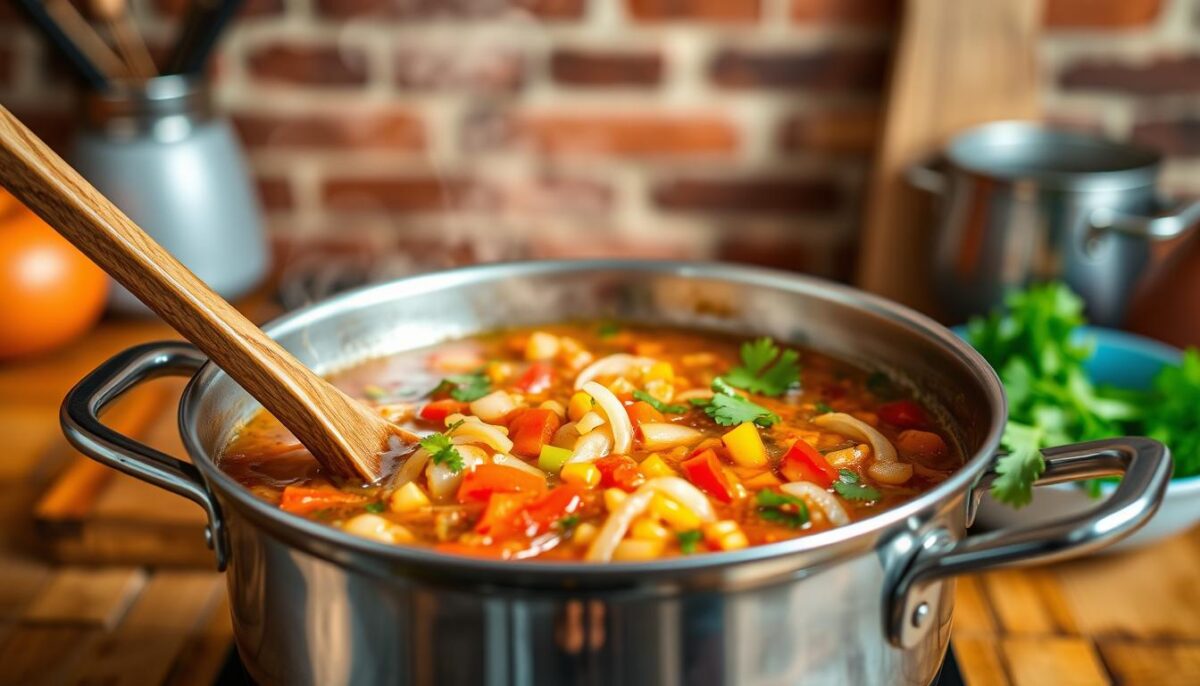
Building Flavor with Spices and Citrus
Creating authentic sofrito taught me the power of patience. Start with diced onions and green pepper sizzling in olive oil. Add minced garlic just before it browns – this preserves its sharpness. Stir in ground cumin and oregano, letting spices toast for 20 seconds. Finish with tomato paste diluted in lime juice. This foundation elevates everything from beans to stews.
Using Wine and Garlic to Enhance Dishes
Deglazing pans with dry white wine became my secret weapon. After searing meats, pour in a splash and scrape up browned bits. Simmer until the liquid reduces by half, creating instant depth. For garlic lovers: roast whole cloves until caramelized, then mash into sauces. The sweet-savory punch transforms ordinary gravies.
| Component | Purpose | Pro Tip |
|---|---|---|
| Sofrito | Flavor foundation | Freeze in ice cubes |
| Citrus Zest | Bright acidity | Use microplane grater |
| White Wine | Depth builder | Choose unoaked varieties |
Balance is key. Too tangy? Add honey. Overly spicy? Stir in sour cream. These sauces adapt like chameleons – perfect for drizzling, marinating, or simmering.
Cuban Recipes for Meat Lovers
Sunday afternoons in my kitchen smell like possibility when pork shoulder starts sizzling in olive oil. Meat-centric dishes here aren’t just meals – they’re edible love letters to patience and spice blends. Let’s explore how slow-cooked magic turns tough cuts into melt-in-your-mouth masterpieces.
Slow-Cooked Pulled Pork and Beef Delicacies
My pressure cooker became essential after testing 14 variations of pulled pork. The key? Balance smoke with citrus. Rub a 4-pound shoulder with garlic powder, cumin, and oregano. Sear until golden, then simmer in orange juice and bay leaves. “Low and slow wins every time,” a Tampa chef once told me – advice that’s never failed.
For ground beef lovers, picadillo showcases versatility. Brown the meat with raisins and green olives for sweet-salty contrast. I’ve found adding potato cubes creates hearty texture. Serve over rice for a meal that satisfies even picky eaters.
| Cut | Cook Time | Best Method | Pro Tip |
|---|---|---|---|
| Pork Shoulder | 8 hours | Slow cooker | Add beer for tenderness |
| Chuck Roast | 6 hours | Instant Pot | Use bone broth |
| Ground Beef | 45 mins | Stovetop | Toast spices first |
Pair these proteins with black beans simmered in sofrito. Last Christmas, I fed 20 relatives using this method – the empty pans spoke volumes. Whether hosting or meal prepping, these recipes turn ordinary ingredients into extraordinary comfort food.
Quick and Simple Cuban Recipes for Weeknights
Who says vibrant meals require hours? My Thursday night breakthroughs prove authentic tastes thrive under time constraints. Let’s explore how smart shortcuts and clever swaps keep weeknight dinners exciting without sacrificing soul.
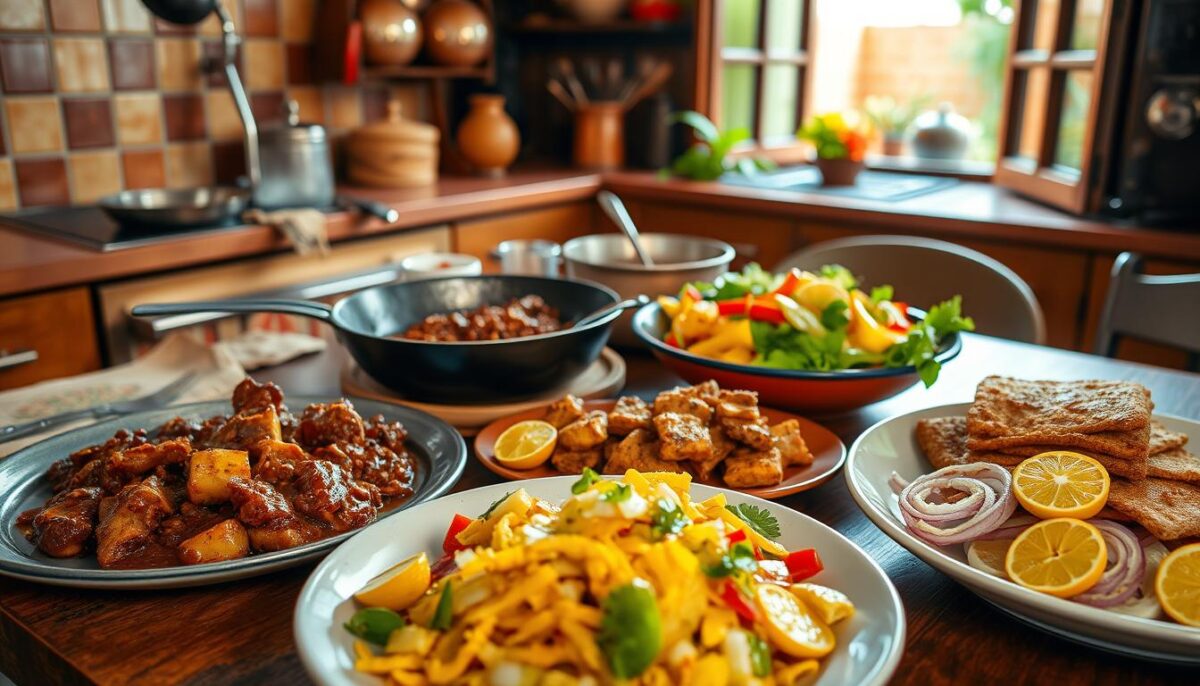
Effortless Recipes for Busy Days
My 30-minute chicken fricassee became a fan favorite after testing 12 variations. Sear thighs with onions and peppers, then simmer in tomato sauce with oregano. Serve over rice cooked in broth – the grains absorb every drop of flavor. Inspired by A Sassy Spoon’s approach, I keep pre-chopped sofrito in my freezer for instant depth.
| Dish | Time Saver | Key Ingredients |
|---|---|---|
| Black Bean Soup | Canned beans | Cumin, lime |
| Mojo Pork Tacos | Pre-marinated meat | Citrus, garlic |
| Yuca Fries | Frozen yuca | Mojo dipping sauce |
Modern Twists on Tradition
Last Tuesday’s meal revelation? Cauliflower rice makes perfect partners for picadillo. The texture mimics grains while letting the spiced ingredients shine. For vegetarians, try lentils instead of beef in your next recipe – their earthiness pairs beautifully with traditional spices.
My secret weapon? A blazing hot skillet. Proper searing creates complex flavors fast. As one Tampa cook told me, “Good cooking isn’t slow – it’s smart.” These dishes prove tradition and convenience can coexist deliciously.
Mastering Cuban flavors home cooking Techniques
My hands still remember the first time I properly crushed garlic for sofrito – that sizzle when it hit hot oil changed everything. Great meals here hinge on foundational skills passed through generations. Let’s break down the methods that turn simple components into unforgettable plates.
Step-by-Step Recipe Guidance
Start with mise en place. Measure spices first – I use small bowls for ground cumin (1 tsp) and oregano (½ tsp). For shredded beef dishes:
- Pat meat dry with paper towels
- Sear on medium-high until crust forms
- Deglaze pan with ¼ cup white wine
Timing matters. Add sofrito after deglazing – too early, and garlic burns. Too late, and flavors won’t meld. My trick? Use a bench scraper to transfer chopped ingredients quickly.
| Technique | Key Tools | Pro Tip |
|---|---|---|
| Braising | Dutch oven | Keep lid slightly ajar |
| Plantain Prep | Wooden tostonera | Soak in lime water |
| Mojo Making | Citrus juicer | Use room-temp limes |
Subtle shifts create big differences. Picadillo needs constant stirring for even texture, while ropa vieja requires hands-off simmering. Test heat levels by hovering your palm – if you pull back at 3 seconds, it’s perfect for caramelizing onions.
These methods transformed my weeknight recipes. Now I approach each pot with confidence, knowing the techniques work whether I’m cooking for two or twenty. Your turn – grab that wooden spoon and let’s make magic.
Essential Ingredients and Tools for Cuban Cooking
Stocking your kitchen for these recipes feels like assembling a painter’s palette – every spice and tool unlocks new possibilities. Through trial and error, I’ve found that success hinges on a few versatile items that bridge tradition and modern convenience.

Pantry Must-Haves in an American Kitchen
Start with a solid chopped onion base – it’s the foundation of sofrito and countless stews. Fresh lime juice beats bottled every time, adding bright acidity to marinades and beans. Ground cumin should smell earthy-sweet; stale spices won’t deliver authentic depth.
Long-grain rice becomes magic when simmered in broth. I stock up during sales – it’s cheaper than specialty blends and just as versatile. Green plantains might intimidate at first, but they’re easier to find than you’d think. Check Latin markets or the tropical produce section.
Ingredient Substitutions and Sourcing Tips
No sour oranges? Mix lemon juice with orange zest. For hard-to-find yuca, try frozen chunks – they steam beautifully. My local grocer surprised me with fresh malanga last week, but sweet potatoes work in a pinch for fritters.
Essential tools don’t need to be fancy. A sturdy mortar and pestle crush garlic better than any gadget. I use my Dutch oven weekly for slow braises. And that dented tostonera? It’s transformed more plantains than I can count.
Building this pantry changed my weeknight meals. Suddenly, black beans simmered with toasted cumin and diced onion became my signature dish. The right ingredients turn ordinary cooking into something that feels like a Havana sunset.
Final Thoughts on Embracing Cuban Cuisine
Sunday dinners transformed when I served my first successful ropa vieja. My niece, usually glued to her phone, leaned in for seconds. “Tastes like Abuelo’s,” she murmured. That moment crystallized why these recipes matter – they’re bridges between generations.
Recreating roast pork marinated in bitter orange or slow-braised beef isn’t just cooking. It’s preserving stories. A Tampa chef once told me, “Food is the thread that stitches generations together.” Her words echo each time I layer a Cuban sandwich or fry plantains for my kids.
“Every dish carries the hands that shaped it – your kitchen becomes their legacy.”
Balancing tradition with modern twists keeps these meals alive. My pressure cooker cuts braising time, but I still toast cumin seeds in a clay pot inherited from my mother. Classics like black beans gain new life when paired with quinoa or spiralized veggies.
| Occasion | Recommended Dish | Key Ingredient | Heritage Tip |
|---|---|---|---|
| Family Reunions | Lechón Asado | Mojo-marinated pork | Use a charcoal grill |
| Weeknight Dinners | Picadillo Tacos | Ground beef + raisins | Add potato cubes |
| Holiday Desserts | Guava Pastelitos | Puff pastry | Freeze before baking |
These recipes aren’t museum pieces – they’re living traditions. Whether you’re simmering beans for two or roasting pork for twenty, each meal becomes a celebration. Grab that wooden spoon. Your kitchen’s waiting to become part of the story.
Conclusion
Creating these dishes has taught me that great meals aren’t just about taste—they’re bridges between past and present. From ropa vieja’s tender shreds to the satisfying crunch of tostones, each bite carries stories shaped by generations. These recipes thrive on simplicity: fresh garlic, citrus-kissed marinades, and slow-simmered beans transform humble ingredients into something extraordinary.
Whether mastering the layers of a pressed sandwich or balancing saffron in arroz con pollo, success lies in respecting tradition while embracing creativity. My biggest lesson? Quality matters. Toasting ground cumin unlocks earthy depth, while ripe plantains ensure golden results every time. Don’t fear substitutions—swap yuca for potatoes or try rotisserie chicken in stews. The goal is making these dishes your own.
Now it’s your turn. Whip up black beans rice for Tuesday’s dinner or host a weekend meal starring garlicky mojo pork. Share your twists online—tag me @CubanKitchenMagic. Let’s keep these vibrant traditions sizzling in kitchens across the country, one recipe at a time.
FAQ
What makes Cuban cuisine stand out?
I love how it blends Spanish spices, African stew techniques, and Taíno staples like yuca. Garlic, cumin, and citrus create bold layers in dishes like ropa vieja or arroz con pollo.
Can I make black beans and rice without a pressure cooker?
Absolutely! I simmer mine low and slow with bay leaves, green peppers, and a splash of vinegar. It’s all about letting the sofrito work its magic.
How do I keep tostones crispy?
Fry green plantains twice—once to soften, then again after smashing. I sprinkle them with garlic-lime mojo right after frying for that signature crunch.
What’s the secret to a great Cuban sandwich?
Pressing is key! Layer roast pork, ham, Swiss cheese, pickles, and mustard between crusty bread. Grill until the cheese melts and the bread crackles.
Can I substitute ingredients if I can’t find them locally?
Yes! Swap achiote with paprika for color, or use lime juice if bitter oranges are unavailable. I’ve even used Greek yogurt instead of queso blanco in pastries.
Is sofrito necessary for every dish?
Not always, but it’s a flavor powerhouse. My go-to mix includes onions, bell peppers, garlic, and tomatoes sautéed in olive oil—perfect for beans, soups, or meats.
What’s a quick weeknight Cuban-inspired meal?
Try picadillo! Brown ground beef with onions, garlic, cumin, and raisins. Serve over rice with fried plantains—it’s ready in 30 minutes.
How do I balance sweetness in desserts like flan?
I use caramelized sugar sparingly and add a pinch of salt to the custard. For guava pastries, pair the fruit’s sweetness with cream cheese for contrast.
Can I prepare Cuban pulled pork in a slow cooker?
Definitely! Marinate pork shoulder with mojo (garlic, citrus, oregano) overnight, then cook on low for 8 hours. Shred it for sandwiches or rice bowls.
What wine pairs well with Cuban dishes?
I lean toward dry whites like Sauvignon Blanc with garlic-heavy dishes. For richer meats, a light red like Tempranillo complements cumin and paprika flavors.
